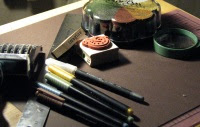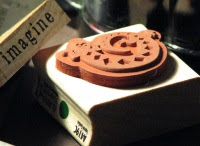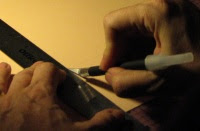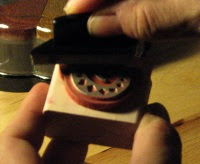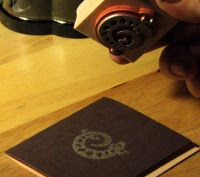Wood Mount
This is the kind of rubber stamp that I started with. It is a rubber image and a cushion adhered to a wooden block. There is an image on the back of the block to show you what your stamped image will look like. Some times these images are in color. This is just to show what the image looks like after you color it. This is just a suggestion, you can color the image anyway you want to.
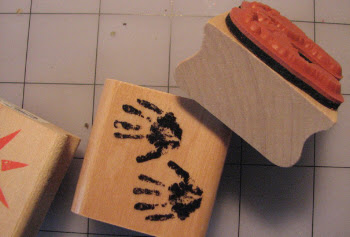 Small wood mount rubber stamps.
Small wood mount rubber stamps.
Unmounted
When I first started ordering on-line I discovered this kind of stamp. This is just the rubber image, no cushion, no wooden block. These are less expensive and the postage is usually less too. I built up my collection of rubber stamps quickly with these.
To stamp with this kind you will need an acrylic block and either double sticky tape or a repositionable glue. I use Aleene's Tack-It-Over & Over Glue. I spread a thin layer of glue on the back of the rubber image and let it dry. Now it is tacky and ready to stick to the acrylic block. After using the stamp, just peel it off the acrylic block. When using this kind of rubber stamp you can see where your stamped image will be.
At YouTube, there is a video by pinkcatstudio that is a tutorial with unmounted rubber stamps. This is a good video that shows how to use EZ Mount foam mounting sheets from Sunday International. It comes in a sheet that is sticky on one side and has a cushion and static cling plastic on the other side.
As the video explains, you stick the rubber image to the sticky side of the sheet. Use Kai scissors to cut through the set of rubber images and the EZMount foam. These scissors are very sharp. Stamps mounted this way cling to the acrylic block and peel off easily with no mess. Once again, you will be able to see where your stamped image will be.
Acrylic Mount
This kind of stamp is a clear rubber image mounted on a clear acrylic block. There is an image on the other side of the block that shows what your stamped image will look like. With this kind of stamp you can see exactly where your stamped image will be.
Acrylic Block and Cling Stamps
These are also clear unmounted rubber stamps. This kind will adhere to the acrylic block themselves. These are becoming popular in my area. Hobby Lobby has a nice selection of these. I have even found some of these at my HEB grocery store. To use this kind, stick it to the acrylic block, ink, and stamp. These are great rubber stamps. One set of acrylic blocks is all you need. After you stamp your image, just peel it off the block and stick it back on the plastic storage sheet it comes with. These rubber stamps take up very little storage space because they all use the same set of acrylic blocks. Once again, you will be able to see exactly where your stamped image will be.
 Cling stamps on acrylic block and on storage sheet.
Cling stamps on acrylic block and on storage sheet.Foam Mounted Stamps
Another kind of stamp I enjoy using are the foam stamps. These have bold images that I love to emboss and cut out. They are inexpensive and lots of fun. The larger stamp of this kind is used to stamp on walls and furniture using acrylic paint. Sometimes the foam stamps are on a cube with four images. These usually sell for less that a dollar. Wal-Mart has these during the holidays. I have found sets of foam stamps at Target also.
With all of the different rubber stamps the ideas are limitless. I don't have a favorite kind -- I love them all.




